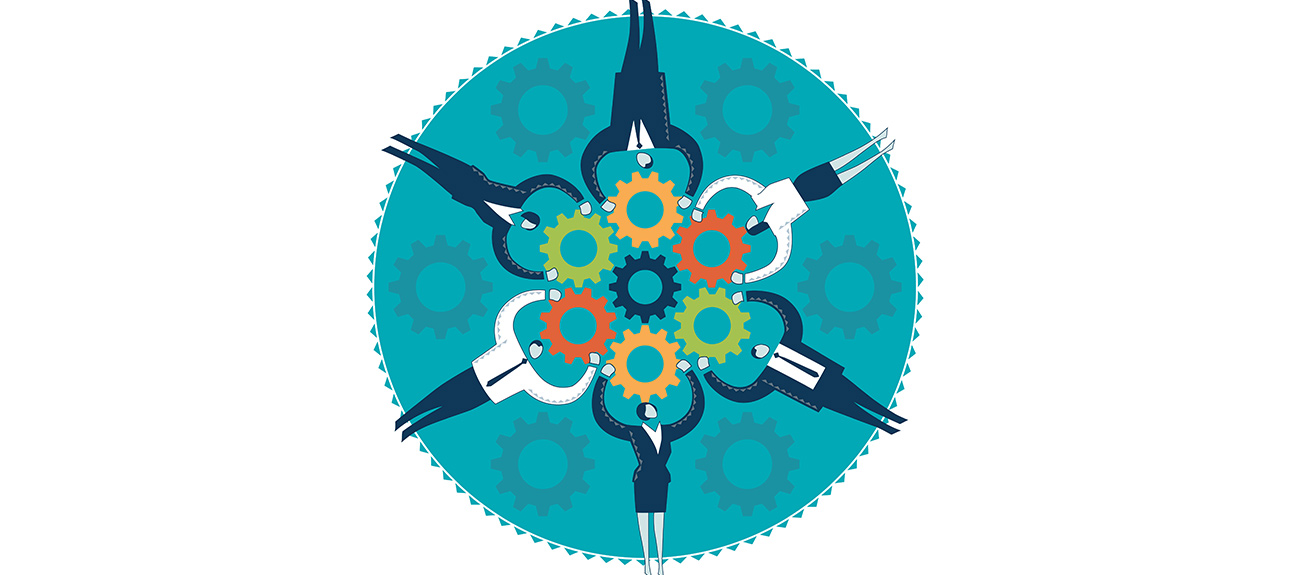Twenty-eight learning and development (L&D) professionals gathered at IMD on November 7-8, 2013 to participate in our inaugural Cocreating Transformation Journeys event. The event represented IMD’s commitment to give back to our valued partners, from whom we have learned so much over the years. Professor Anand Narasimhan and Research Fellow Jean-Louis Barsoux have co-written the IMD book Quest: Leading Global Transformations encapsulating IMD’s thought leadership and research, which is the fruit of the journeys we have taken together.
Corporations must learn and adapt to thrive in the rapidly changing business environment. In its 25 years of existence, IMD has worked with some of the best and most sophisticated organizations on their business transformation journeys. Together, Faculty and their partner companies have researched and developed insights into how companies deal with the ever-changing landscape. IMD’s forthcoming book,1 Quest: Leading Global Transformations, distills the lessons IMD has learned while working with its partner companies throughout the years into seven global journeys that are reshaping corporations. The book’s content is underpinned by IMD case studies and other joint research.
The seven transformation journeys
- The quest for global presence is about becoming “truly global” in terms of both back-end (IT, corporate services, logistics, etc.) and front-end (markets and product/service lines) organization.
- The quest for global value generation is about developing an organization-wide focus on value creation and capture.
- The quest for global leadership development is about building up a distributed leadership capability (monitoring and developing the leadership competencies of executives) at all levels of the organization.
- The quest for global solutions is about becoming a solution provider rather than just a supplier of products and services.
- The quest for global agility is about becoming more strategically or operationally agile, notably by reducing complexity.
- The quest for co-innovation is about opening the organization’s R&D boundaries by incorporating innovation from external sources.
- The quest for global sustainability is about moving beyond mere compliance by fully integrating corporate social responsibility into the company’s strategic positioning and execution.
The primary focus of IMD’s Faculty is executive education. They collaborate with both partner companies and the IMD Client Engagement team to design and deliver programs tailored to meet partner companies’ immediate needs, while accompanying them on their longer-term journeys. In addition to teaching, IMD Faculty spends a considerable amount of time reflecting on what they have learned from their collaboration with clients and then sharing their research insights through case studies, articles and books.
Co-creation lessons
IMD has discovered a lot about co-creating programs with our partner companies over the years. Professors Albrecht Enders, Sean Meehan and Don Marchand invited some of their partner companies to share their lessons from these co-created partnership programs. The partner companies, which came from a variety of industries ranging from industrial to services, were at different stages in their transformation journeys. Their experience with L&D activities ranged from just starting out to having many years and highly sophisticated experience. Five lessons learned emerged from the event.
Top team alignment and sponsorship
Transformation journeys do not happen in a vacuum. All the Faculty and partner companies that took part in the November event agreed that support from the CEO and the top team was critical for various reasons. A CEO who participates in programs, for example by attending and evaluating the work teams’ presentations on project solutions, signals how important the program is to helping the organization achieve its business objectives. It also underscores how serious the CEO is about taking all necessary steps to execute the company’s strategy.
Professor Enders and one of his partner companies agreed to open seats on its transformation program to anyone in the company. Around 200 people applied. All applicants underwent rigorous screening and 15 were finally accepted. The aim was to ensure that the program benefitted from as much diverse thinking as possible. This decision clearly highlighted how important the CEO considered the transformation journey to be for the organization.
Professor Meehan and his partner company decided to restrict their transformation program to leaders who would bring about the desired change through their specific roles. The top team’s support was crucial, especially when the HR partner had to inform senior leaders – who would normally have been a candidate for such a program – that they did not have the required profile on this occasion.
Top-team support is essential to develop an understanding of the organization’s strategy, what challenge it needs to solve and its level of maturity in terms of L&D. It is also needed to encourage leaders to propose projects that positively impact business results and to measure impact. Without it, IMD and its partner organizations would be less effective at co-creating impactful programs.
Understand what challenges the organization needs to solve
When working together, IMD and partner companies first strive to understand the organization’s strategy, then what specific challenges the new program should address. Professor Meehan and his partner company – with which IMD has a long history of delivering leadership development programs – explained what they had accomplished together. In 2010 the company decided it needed to become serious about its focus on customer centricity. A large portion of its sales came from service contracts and the easiest way to grow the business was for customers to renew their agreements. But although the company’s engineers excelled at delivering high-quality workmanship, they needed to become more service-oriented to improve customer loyalty.
The professor and the company organized different site visits to interview executives at all levels in an effort to fully understand the challenges the organization faced, why customer excellence mattered now and what obstacles they would have to overcome. For example, some managers were not convinced that the top management team really “got” the need to change – “were they really walking the talk?” Others said that they always heard about problems from the perspective of the home country and wanted to contribute more from a global perspective. Professor Meehan and his partner company incorporated what they had learned into the program design.
Developing a shared understanding of the challenges an organization faces is a lengthy process that involves multiple site visits and back-and-forth communications. Having grasped the issues that need to be solved, the professor and the partner company can turn their attention to designing a tailored program to address the specific challenges. The reward for investing a considerable amount of time upfront is the design and delivery of the most effective program.
Understand the company’s L&D maturity
Not all organizations have the same level of experience in using executive education; for some it is their first experience, while others have undergone multiple programs and want the most innovative design possible. IMD works with its partner companies to ascertain their L&D histories and capabilities, then tailor programs to suit their specific needs. Too much innovation for partner companies with less L&D experience can be confusing; whereas too little innovation for those with more L&D maturity can seem old-fashioned.
IMD realizes how important it is to understand its partner company’s L&D maturity when co-creating appropriate program designs. Professor Marchand shared his experience with a partner company – a new user of executive education – that wanted to improve its internal and external collaboration. Much of Professor Marchand’s early interaction with the partner company involved helping it understand how IMD could help it achieve its goals. After considerable back-and-forth interaction, Professor Marchand and the partner company identified what they should focus on and co-designed an impactful program.
Link learning projects to business results
All the collaborations highlighted during the event linked project work to business results. According to Professor Enders, practical projects add value when they are truly challenging and tackle issues that affect business results. Only projects that directly impact individuals and organizational-level results can help embed changes in the organization.
One of Professor Enders’s partner companies described how the organization’s leaders had been reluctant to assign their projects for use in the transformation program. It was only once everyone realized the benefits of the projects – innovative solutions with high visibility because they were presented to the executive committee – that executives enthusiastically signed up. The partner company now has 40 projects.
Another partner company shared how its first action-learning projects had not been mission critical, which led to disappointing solutions. Learning from this, Professor Enders and the partner company urged the use of more strategic projects in future iterations. The partner company was so happy with the high-quality results that the CEO planned to present them to the board.
Linking projects to business results also keeps participants engaged in the program between modules, which can have a significant, positive impact on the organization’s results. These results can, in turn, be used to demonstrate the program’s impact.
Use the right tools to measure impact
Faculty and partner companies allow time to reflect and learn from each program and then use their insights to adapt the next iterations as needed. They also provide ways to measure the impact. Professor Meehan and his partner company, which was focusing on customer centricity, taught participants to use Net Promoter Score (NPS) on the program, integrated NPS into the company’s business processes, then used it to measure the program’s ROI. The program received excellent feedback and turned out to be one of the most successful external courses the partner company had ever run.
Professor Marchand and his partner company started delivering co-created leadership development programs. A few months later, they rolled out their co- created concurrent strategy execution programs. Both programs used action-learning projects, although the standards set for the strategy execution projects were more exacting than those for the leadership development ones. The tougher standards had such a strong impact that everyone started applying them to the leadership development projects as well.
Correctly measuring a program’s impact allows IMD and its partner companies to adapt program designs to ensure the most positive effect possible on business results. Without such data, we would surely miss out on important information needed to co-create the best program design and to continue to accompany the organization on its journey as it develops.
Trust and collaboration is key to co-creation
The global environment is constantly changing, and at an increasingly rapid pace. So to remain competitive, organizations must be agile. IMD Faculty, the Client Engagement team and the partner companies discussed in this insights@IMD collaborated to build trust and fully understand the strategic issues the companies faced as well as their L&D maturity in order to design the most appropriate and effective program possible and to adapt it along the journey as the needs of the organizations evolved.
But this collaboration does not end with program delivery. It continues after the program, with conversations to help keep the clients and IMD agile and ensure the relevance of future programs in the changing business landscape.


